

The Americas had at least two major centers for domestication, and probably several minor ones. Primarily these centers are for domesticated plants; if you remember the earlier lessons, the Americas had little in the way of potentially domesticable animals. The guinea pig was probably first domesticated as early as 3500 BC, the llama by 3500 BC, and the alpaca by 1500 BC, all three in Peru. There appears no good evidence regarding the domestication of the Muscovy duck, but it certainly long pre-dated Spanish contact, and was no doubt first domesticated in its homeland of South and Central America. Domestication of the final animal on the American list, the turkey, was not accomplished until around 100 BC, in Mexico and perhaps also further north. Farmers in the Americas always were forced to supplement their diet by hunting and fishing.
In terms of plants however, the Americas were much richer. As a result, horticulture developed independently in Mexico and in Peru almost as early as it did in Asia. Crops like maize or corn, potatoes, many beans and squashes, and cassava or manioc, feed millions today.
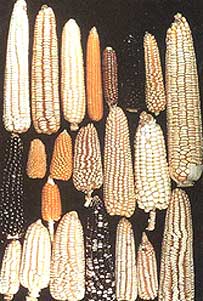
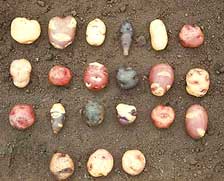
Modern Varieties of Maize from Mexico, and of Potatoes from Peru


Manioc or Cassava: The plant can grow over 10 feet tall, but it is the tuberous roots (at right, with part of hand clippers at bottom) which are eaten.
The oldest horticultural sites in MesoAmerica are cave sites from two different valleys in the southern part of Mexico. One valley is that of Oaxaca (see below) where the site of Guila Naquitz is located. The second valley is that of Tehuacan, located just to the north of the State of Oaxaca on the small map. In general for these and other early MesoAmerican sites of domestication, people continued to forage for wild plants at the same time as they were domesticating other plants. Only gradually did agricultural products become the most important food source.
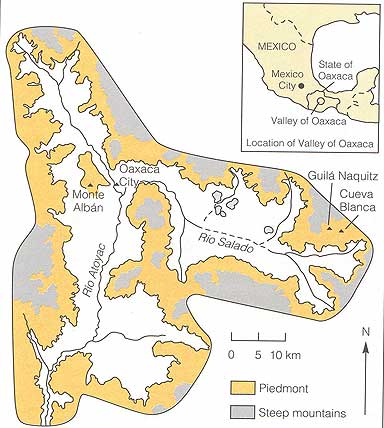
At Guila Naquitz, beans and squash are found domesticated as early as 8,000 BC. Although maize was not present at the earliest levels, it is still fairly early at 3,400 BC. At other sites in Mexico and Central America, evidence of domesticated maize is present as early as 5,000 BC. Studies and dating of maize phytoliths (silica or calcium oxide deposits that accumulate in the spaces between cells in stems, leaves and roots), pollen, and starch grains from several sites have recently lead some researches to conclude that maize was also domesticated by 8,000 BC. (Click here for article, not required.) Beans, squash, and maize were the three crops that formed the basis of food production throughout MesoAmerica, and were carried north into much of what is now the United States as horticulture spread. (Guila Naquitz and the Tehuacan Valley sequence is covered more completely in the text, pp. 243-253.)
Potatoes, sweet potatoes, the peanut, beans, squash, and cassava or manioc, were all domesticated in various places in tropical South America. At Guitarrero Cave in Peru, two species of domesticated bean and domesticated squash have been found, together with a couple of little known root crops, dated at around 8,000 BC. Maize may also be present at this site by 6,000 BC, and has certainly reached the Peruvian highlands by 4-3,000 BC. (Both beans and squash were independently domesticated in both Mexico and Peru.) Peanuts have been found domesticated in Peru as early as 7,000 BC, along with squash and cotton. (Cotton was also independently domesticated in Mexico, in Ethiopia, and in India.)
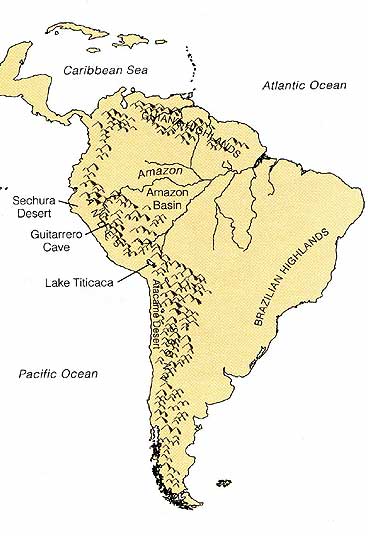
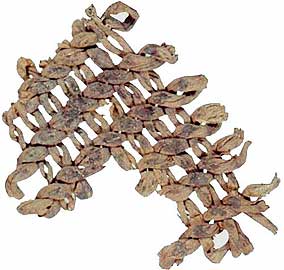
South American Map showing location of Guitarrero Cave, and Woven Twine from that Site
The dates and locations for the domestication of other South American crops is still uncertain. Potatoes were certainly found at various sites on the Peruvian coast by 2,000 BC, but are believed to have been domesticated much earlier. The sweet potato is also found domesticated in Peru by 2,500 BC. The exact date of the domestication of the tuber manioc (cassava or tapioca) is still uncertain, but it almost certainly was domesticated before 2,000 BC in Brazil. (See text, pp. 254-57, for more on Guitarrero Cave.)
Maize clearly spread south as well as north from its originally area of domestication, and manioc and the potato spread north. By 3,000-2,000 BC settled villages, with pottery, were found throughout MesoAmerica, into what is now the United States, and throughout Peru and Columbia and other areas of South America. Subsequent lessons in this unit will deal with the spread of horticulture into what is now the United States, and the eventual development of complex chiefdoms throughout much of that area. In Mexico, Central America, Columbia and Peru, intensive agricultural states developed, which will be covered in unit 3.